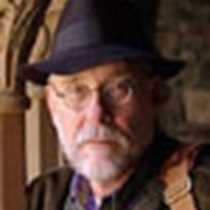Mousa Broch & Fair Isle
After our day of deep history at Jarlshof in Shetland it seemed improbable that anything could top it. But overnight the National Geographic Endeavour had repositioned and by early morning the ancient, massive Mousa Broch loomed on the shore, stunning in its towering symmetry and near perfect preservation. Standing thirteen meters high, no other broch in the British Isles tells such a compelling tale of life on the island shores over 2,000 years ago. Under the near-perfect tower walls historian Tom Heffernan explained how such a massive structure could be built entirely of dry stone with no mortar. Once inside, sitting where iron-age families once sat, we were transfixed as expedition archeologist Carol Knott transported us into their daily life. Ascending the internal staircase sandwiched between the massive inner and outer walls was both dark (we needed flashlights) and illuminating (we finally understood how the broch was constructed). High atop the walls offered a splendid view over the bay where the National Geographic Endeavour waited for us as the skies cleared.
A short sail over lunch and we arrived at Fair Isle, a jewel-like collection of imposing sea cliffs and idyllic rolling pastures barely three miles from top to bottom and lying halfway between Shetland and Orkney. Famed for its knitters, it was also the site of the shipwreck of the Spanish Armada’s flagship in 1588. Landing in a tiny nook befitting smugglers our party soon scattered across the island, taking in the gleaming lighthouse, searching for puffins, strolling the one-lane roads up to the tiny museum near the simple, pretty church, and poking into the island’s only store which serves some 70 islanders. It would be hard to imagine a warmer welcome. Islanders like Brian Wilson (a longtime friend of all Lindblad visitors) were there to meet us, and down the narrow lanes islanders stopped to offer us rides to all the island sights (and to supply a bit of blather and island news as well.) What a delightful afternoon.
But one more highlight awaited us: our return via Zodiacs through the churning tides off of South Port (where the distinctive boats know as Fair Isle yoals lay cradled in their noosts), past the lighthouse, and through impossibly narrow passages among the imposing sea cliffs. Flights of puffins skittered away across the choppy water, and we were entranced as we poked deep into dark, secluded caves sliced into the ancient Devonian rocks.
Recap in the lounge tonight was a bittersweet affair, rich with enthusiastic tales of vivid encounters –– meeting the spinning wheel maker as well as learning of the island funeral held just yesterday –– and the regret of leaving such a fair isle so soon.
After our day of deep history at Jarlshof in Shetland it seemed improbable that anything could top it. But overnight the National Geographic Endeavour had repositioned and by early morning the ancient, massive Mousa Broch loomed on the shore, stunning in its towering symmetry and near perfect preservation. Standing thirteen meters high, no other broch in the British Isles tells such a compelling tale of life on the island shores over 2,000 years ago. Under the near-perfect tower walls historian Tom Heffernan explained how such a massive structure could be built entirely of dry stone with no mortar. Once inside, sitting where iron-age families once sat, we were transfixed as expedition archeologist Carol Knott transported us into their daily life. Ascending the internal staircase sandwiched between the massive inner and outer walls was both dark (we needed flashlights) and illuminating (we finally understood how the broch was constructed). High atop the walls offered a splendid view over the bay where the National Geographic Endeavour waited for us as the skies cleared.
A short sail over lunch and we arrived at Fair Isle, a jewel-like collection of imposing sea cliffs and idyllic rolling pastures barely three miles from top to bottom and lying halfway between Shetland and Orkney. Famed for its knitters, it was also the site of the shipwreck of the Spanish Armada’s flagship in 1588. Landing in a tiny nook befitting smugglers our party soon scattered across the island, taking in the gleaming lighthouse, searching for puffins, strolling the one-lane roads up to the tiny museum near the simple, pretty church, and poking into the island’s only store which serves some 70 islanders. It would be hard to imagine a warmer welcome. Islanders like Brian Wilson (a longtime friend of all Lindblad visitors) were there to meet us, and down the narrow lanes islanders stopped to offer us rides to all the island sights (and to supply a bit of blather and island news as well.) What a delightful afternoon.
But one more highlight awaited us: our return via Zodiacs through the churning tides off of South Port (where the distinctive boats know as Fair Isle yoals lay cradled in their noosts), past the lighthouse, and through impossibly narrow passages among the imposing sea cliffs. Flights of puffins skittered away across the choppy water, and we were entranced as we poked deep into dark, secluded caves sliced into the ancient Devonian rocks.
Recap in the lounge tonight was a bittersweet affair, rich with enthusiastic tales of vivid encounters –– meeting the spinning wheel maker as well as learning of the island funeral held just yesterday –– and the regret of leaving such a fair isle so soon.




